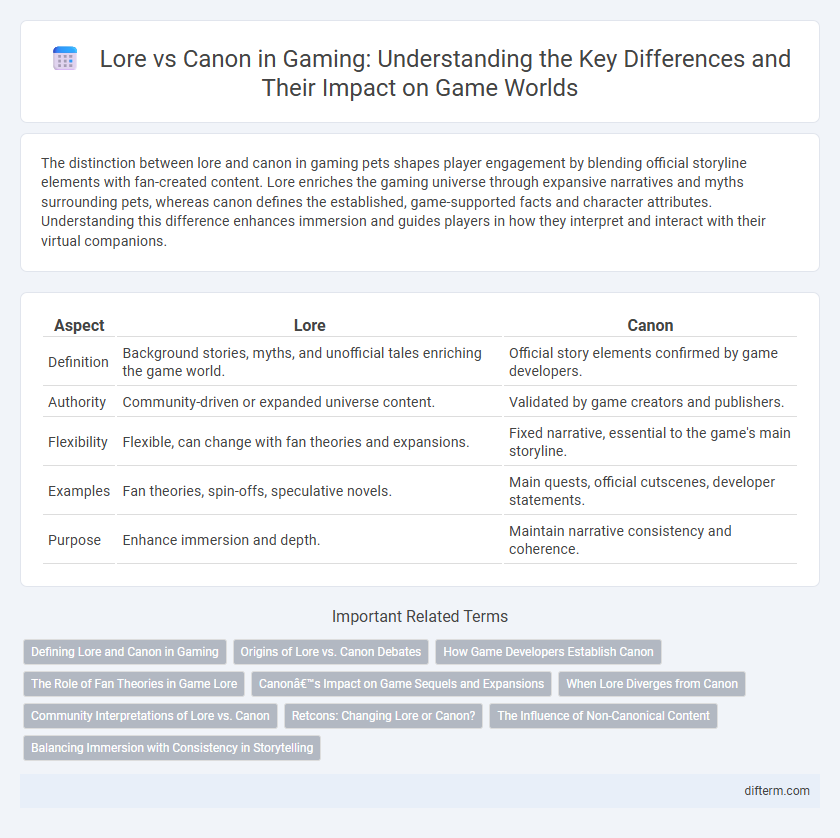The distinction between lore and canon in gaming pets shapes player engagement by blending official storyline elements with fan-created content. Lore enriches the gaming universe through expansive narratives and myths surrounding pets, whereas canon defines the established, game-supported facts and character attributes. Understanding this difference enhances immersion and guides players in how they interpret and interact with their virtual companions.
Table of Comparison
| Aspect | Lore | Canon |
|---|---|---|
| Definition | Background stories, myths, and unofficial tales enriching the game world. | Official story elements confirmed by game developers. |
| Authority | Community-driven or expanded universe content. | Validated by game creators and publishers. |
| Flexibility | Flexible, can change with fan theories and expansions. | Fixed narrative, essential to the game's main storyline. |
| Examples | Fan theories, spin-offs, speculative novels. | Main quests, official cutscenes, developer statements. |
| Purpose | Enhance immersion and depth. | Maintain narrative consistency and coherence. |
Defining Lore and Canon in Gaming
Lore in gaming encompasses the expansive backstory, myths, and world-building elements that enrich the player's immersion. Canon refers to the official narrative and events established by the game's creators, considered authoritative and integral to the storyline. Distinguishing between lore and canon helps players understand which elements influence game mechanics and story progression versus optional or community-created content.
Origins of Lore vs. Canon Debates
Lore in gaming consists of expansive stories, myths, and character backgrounds developed both by creators and the community, often enriching the game universe beyond the official narrative. Canon, by contrast, refers to the officially recognized storyline and facts established by game developers, serving as the definitive source of truth within the game's world. Origins of lore versus canon debates arise from conflicts between player interpretations, fan theories, and the evolving official content that prioritizes narrative consistency and developer intent.
How Game Developers Establish Canon
Game developers establish canon by defining a consistent narrative framework through official storylines, character backgrounds, and world-building elements featured in core game releases and developer-approved media. They often use developer notes, in-game lore entries, and sanctioned expansions to clarify and expand the official universe, distinguishing it from fan theories or extended universe content. Maintaining canon ensures a cohesive gaming experience and preserves narrative integrity across sequels and related media.
The Role of Fan Theories in Game Lore
Fan theories enrich game lore by expanding narrative possibilities beyond the established canon, offering fresh perspectives that deepen player engagement. These theories frequently explore unexplained plot points or character motivations, fueling community discussions and influencing developer awareness. While not officially recognized as canon, fan theories often inspire future game content and contribute to a dynamic storytelling ecosystem.
Canon’s Impact on Game Sequels and Expansions
Canon establishes a consistent foundation that guides the narrative direction and character development in game sequels and expansions, ensuring coherence across installments. Game developers rely on canonical storylines to maintain player immersion and deepen the game's universe, avoiding contradictions that disrupt gameplay experience. This structured continuity enhances fan engagement and influences marketing strategies, shaping the overall success of the franchise.
When Lore Diverges from Canon
When lore diverges from canon in gaming, it creates alternative narratives that enrich the game's universe but challenge the official storyline. Lore often includes fan theories, expanded universe details, and unpublished character backgrounds that add depth but may contradict canonical events established by developers. This divergence allows players to explore multiple interpretations, fostering community engagement while maintaining a clear boundary for what is officially recognized within the game's narrative continuity.
Community Interpretations of Lore vs. Canon
Community interpretations of gaming lore often extend beyond official canon by exploring fan theories, unofficial backstories, and speculative connections within the game's universe. These interpretations enrich player experience through shared narratives and debates, fostering a deeper engagement with characters, events, and settings. While canon remains the definitive source material established by developers, community-driven lore shapes the evolving understanding and cultural significance of the game world.
Retcons: Changing Lore or Canon?
Retcons often blur the line between lore and canon by altering established story elements within a game's universe, challenging players' understanding of the narrative consistency. Lore encompasses the broader background and unofficial stories that enrich the game's world, while canon refers to the official, accepted storyline acknowledged by developers. When retcons occur, they can either revise the canon to accommodate new plot developments or reshape lore to align with current narrative directions, impacting the continuity and player immersion.
The Influence of Non-Canonical Content
Non-canonical content in gaming often expands the universe by introducing alternative storylines, character developments, and world-building elements that official lore does not cover. These materials influence player engagement and community discussions by providing diverse interpretations and creative freedom, fostering a richer gaming experience. Despite lacking canonical status, such content can shape fan theories and inspire future official narratives within game franchises.
Balancing Immersion with Consistency in Storytelling
Lore enriches the gaming experience by providing expansive backstories and intricate world-building, while canon establishes the definitive narrative framework essential for maintaining story consistency. Balancing immersion with consistency involves integrating player-driven lore elements without contradicting established canon, allowing for dynamic storytelling that respects the core narrative. Effective game design ensures these elements coexist, enhancing engagement through a cohesive yet flexible story universe.
lore vs canon Infographic

 difterm.com
difterm.com